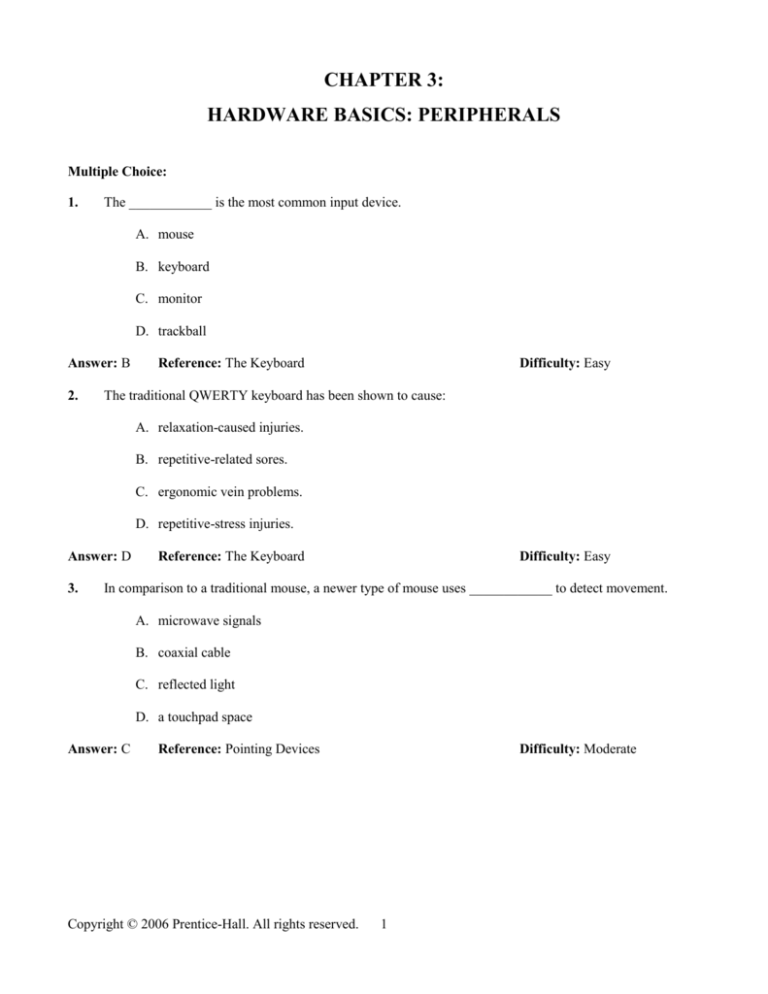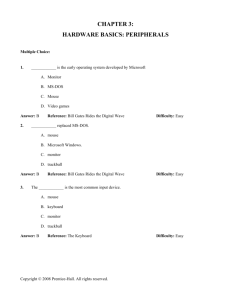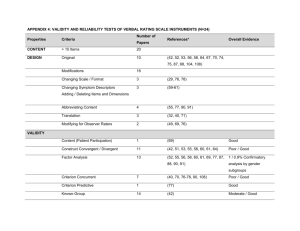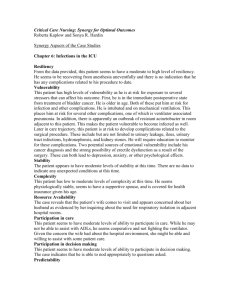
CHAPTER 3:
HARDWARE BASICS: PERIPHERALS
Multiple Choice:
1.
The ____________ is the most common input device.
A. mouse
B. keyboard
C. monitor
D. trackball
Answer: B
2.
Reference: The Keyboard
Difficulty: Easy
The traditional QWERTY keyboard has been shown to cause:
A. relaxation-caused injuries.
B. repetitive-related sores.
C. ergonomic vein problems.
D. repetitive-stress injuries.
Answer: D
3.
Reference: The Keyboard
Difficulty: Easy
In comparison to a traditional mouse, a newer type of mouse uses ____________ to detect movement.
A. microwave signals
B. coaxial cable
C. reflected light
D. a touchpad space
Answer: C
Reference: Pointing Devices
Copyright © 2006 Prentice-Hall. All rights reserved.
Difficulty: Moderate
1
Chapter 3: Hardware Basics: Peripherals
4.
The most common pointing input device is the:
A. trackball.
B. mouse.
C. touchscreen.
D. touchpad.
Answer: B
5.
Reference: Pointing Devices
Difficulty: Easy
The wheel located between the two standard buttons on a mouse is used to:
A. click in Web pages.
B. scroll.
C. click and select items.
D. jump to different Web pages.
Answer: B
6.
Reference: Pointing Devices
Difficulty: Easy
A touchpad responds to:
A. light.
B. pressure.
C. clicking.
D. the sense of heat from fingertips.
Answer: B
7.
Reference: Pointing Devices
Difficulty: Moderate
The pointing device that comes built in to a portable computer can be any EXCEPT a:
A. mouse.
B. trackball.
C. touchpad.
D. pointing stick.
Answer: A
Reference: Pointing Devices
Copyright © 2006 Prentice-Hall. All rights reserved.
Difficulty: Easy
2
Chapter 3: Hardware Basics: Peripherals
8.
Which input device resembles an upside-down mouse?
A. Touchpad
B. Pointing stick
C. Trackpad
D. Trackball
Answer: D
9.
Reference: Pointing Devices
Difficulty: Easy
A ____________ uses pressure as a user presses it with a stylus.
A. touchpad
B. TrackPoint
C. graphics tablet
D. trackpad
Answer: C
10.
Reference: Pointing Devices
Difficulty: Moderate
Bar-code readers use light to read:
A. UPCs.
B. UPSs.
C. POSs.
D. optical marks.
Answer: A
11.
Reference: Reading Tools
Difficulty: Moderate
A standardized test that you may have taken in school could have been scored by a(n):
A. optical mark reader.
B. bar code reader.
C. magnetic ink character reader.
D. scanner.
Answer: A
Reference: Reading Tools
Copyright © 2006 Prentice-Hall. All rights reserved.
Difficulty: Challenging
3
Chapter 3: Hardware Basics: Peripherals
12.
____________ is used to read UPCs.
A. Magnetic ink
B. Light
C. Magnetic tape
D. A sensor
Answer: B
13.
Reference: Reading Tools
Difficulty: Moderate
A ____________ is used to read handwritten or printed text to make a digital image that is stored in
memory.
A. printer
B. laser beam
C. scanner
D. touchpad
Answer: C
14.
Reference: Reading Tools
Difficulty: Moderate
OCR stands for:
A. optical coding recognizer.
B. ostensibly characterized reader.
C. optical character recognition.
D. original character reader.
Answer: C
15.
Reference: Reading Tools
Difficulty: Moderate
OCR is:
A. hardware.
B. firmware.
C. an input device.
D. software.
Answer: D
Reference: Reading Tools
Copyright © 2006 Prentice-Hall. All rights reserved.
Difficulty: Moderate
4
Chapter 3: Hardware Basics: Peripherals
16.
A PDA is a handheld ____________ computer.
A. pen
B. touchscreen
C. touchpad
D. trackball
Answer: A
17.
Reference: Reading Tools
Difficulty: Easy
Until computer recognizing handwriting, an input device must:
A. store the information in secondary storage.
B. optimize the information.
C. digitize the information.
D. show the information on a screen.
Answer: C
18.
Reference: Digitizing Devices
Difficulty: Challenging
A ___________ is used to create a digital representation of a printed document or photograph.
A. scanner
B. monitor
C. video digitizer
D. videoconferencing device
Answer: A
19.
Reference: Digitizing Devices
Difficulty: Easy
If employees reside in different parts of the country and need to meet monthly, useful computer technology
would be:
A. video-display software.
B. video digitizing.
C. videoconferencing.
D. video scanning.
Answer: C
Reference: Digitizing Devices
Copyright © 2006 Prentice-Hall. All rights reserved.
Difficulty: Easy
5
Chapter 3: Hardware Basics: Peripherals
20.
____________ can interpret voice data into words that can be understood by the computer.
A. Speech input hardware
B. Talking software
C. Word recognition software
D. Speech recognition software
Answer: D
21.
Reference: Digitizing Devices
Difficulty: Easy
A limitation of software that digitizes voice data is that it:
A. is prohibitively expensive.
B. must be trained to recognize individual voices.
C. can only be used on high-end computers.
D. cannot be used on portable computers.
Answer: B
22.
Reference: Digitizing Devices
Difficulty: Moderate
For a computer to recognize and understand analog data, it must first be:
A. sent to a mainframe for interpretation.
B. analyzed by the ALU of the CPU.
C. digitized.
D. analyzed for viruses.
Answer: C
23.
Reference: How It Works: 3.1 Digitizing the Real World
Difficulty: Moderate
The display size of a monitor is measured:
A. diagonally.
B. horizontally.
C. vertically.
D. from center to the furthest corner.
Answer: A
Reference: Screen Output
Copyright © 2006 Prentice-Hall. All rights reserved.
Difficulty: Moderate
6
Chapter 3: Hardware Basics: Peripherals
24.
The higher the resolution of a monitor, the:
A. larger the pixels.
B. closer together the pixels.
C. further apart the pixels.
D. less clear the screen is.
Answer: B
25.
Reference: Screen Output
Difficulty: Moderate
The portion of RAM for the video adapter is known as:
A. VRAM.
B. virtual RAM.
C. video ROM.
D. VVRAM.
Answer: A
26.
Reference: Screen Output
Difficulty: Moderate
An advantage that LCD monitors have over CRT monitors is that LCDs are:
A. only used on portables.
B. more difficult to steal since they are considerably larger.
C. less expensive.
D. less bulky and lighter-weight.
Answer: D
27.
Reference: Screen Output
Difficulty: Moderate
The colors in CRT video include all EXCEPT:
A. red.
B. green.
C. yellow.
D. blue.
Answer: C
Reference: How It Works: 3.2 Color Video
Copyright © 2006 Prentice-Hall. All rights reserved.
7
Difficulty: Challenging
Chapter 3: Hardware Basics: Peripherals
28.
A pixel is a:
A. picture element or dot on a screen.
B. point of ink on a laser-printed page.
C. point of ink on an ink-jet printed page.
D. light beam used as an input device.
Answer: A
29.
Reference: Screen Output
Difficulty: Challenging
An advantage that impact printers have over nonimpact printers is that impact printers:
A. are quieter than nonimpact printers.
B. can print multipart forms.
C. are much less expensive.
D. are smaller than nonimpact printers.
Answer: B
30.
Reference: Paper Output
Difficulty: Easy
The most common color printers are:
A. lasers.
B. dot-matrix.
C. inkjet.
D. line printers.
Answer: C
31.
Reference: Paper Output
Difficulty: Easy
In a laser printer, what creates electrical charges on a drum that then attracts ink to those areas?
A. Laser beam
B. Magnetic beam
C. Digitized beam
D. Ion-charged beam
Answer: A
Reference: Paper Output
Copyright © 2006 Prentice-Hall. All rights reserved.
Difficulty: Moderate
8
Chapter 3: Hardware Basics: Peripherals
32.
Engineering blueprints are typically printed on a:
A. laser printer.
B. scanner.
C. digitized tablet.
D. plotter.
Answer: D
33.
Reference: Paper Output
Difficulty: Moderate
For a faxed document with text to be edited, it must be processed by ___________ software.
A. modem
B. fax modem
C. OCR
D. Word
Answer: C
34.
Reference: Fax Machines and Fax Modems
Difficulty: Moderate
If a user wants their computer to accept microphone input, it must have:
A. a sound card.
B. audio software.
C. a synthesizer.
D. speakers.
Answer: A
35.
Reference: Output You Can Hear
Difficulty: Easy
The science of creating work environments that are safe and efficient for workers is known as:
A. ergocentric.
B. ectonomics.
C. ergonomics.
D. environmentally-sound physical planning.
Answer: C
Reference: Working Wisdom: Ergonomics and Health
Copyright © 2006 Prentice-Hall. All rights reserved.
9
Difficulty: Moderate
Chapter 3: Hardware Basics: Peripherals
36.
Input and output secondary storage devices include all of the following EXCEPT:
A. magnetic tape drives.
B. CD-ROMs.
C. hard drives.
D. floppy drives.
Answer: B
37.
Reference: Storage Devices: Input Meets Output
Difficulty: Moderate
A common storage device on mainframe computers but not common on PCs is a:
A. tape drive.
B. DVD.
C. floppy drive.
D. hard drive.
Answer: A
38.
Reference: Magnetic Tape
Difficulty: Moderate
Unlike optical storage, magnetic tape is:
A. laser-read.
B. random.
C. sequential.
D. written with a laser beam.
Answer: C
39.
Reference: Magnetic Tape
Difficulty: Challenging
How is a magnetic disk drive read?
A. Randomly
B. Sequentially
C. Through a laser beam
D. In sequential blocks
Answer: A
Reference: Magnetic Disks
Copyright © 2006 Prentice-Hall. All rights reserved.
Difficulty: Moderate
10
Chapter 3: Hardware Basics: Peripherals
40.
A standard floppy disk holds ____________ of information.
A. 1.88 MB
B. 2.88 MB
C. 1.44 MB
D. 2.2 GB
Answer: C
41.
Reference: Magnetic Disks
Difficulty: Moderate
Zip disks can hold up to ____________ of information.
A. 100 MB
B. 250 MB
C. 750 MB
D. 1,000 MB
Answer: C
42.
Reference: Magnetic Disks
Difficulty: Challenging
CD-RW stands for:
A. compact disc-rewritable.
B. compact diskette, read, write.
C. compact disc, read-only then write.
D. compact diskette with random write capability.
Answer: A
43.
Reference: Optical Disks
Difficulty: Easy
___________ are a type of erasable, reliable, and compact memory that is a viable alternative to disk
storage.
A. DVD disks
B. RAM chips
C. Flash memory
D. CD-RWs
Answer: C
Reference: Solid-State Storage Devices
Copyright © 2006 Prentice-Hall. All rights reserved.
11
Difficulty: Challenging
Chapter 3: Hardware Basics: Peripherals
44.
A tall, upright computer with relatively more expansion slots and bays is known as a(n):
A. tower.
B. desktop.
C. skyscraper.
D. iMac.
Answer: A
45.
Reference: The Computer Systems: The Sum of Its Parts
Difficulty: Easy
Where is a printer attached?
A. Parallel port
B. Serial port
C. SCSI
D. Interface port
Answer: A
46.
Reference: Port and Slots Revisited
Difficulty: Challenging
An internal modem is attached to a(n):
A. bay.
B. expansion slot.
C. SCSI port.
D. parallel port.
Answer: B
47.
Reference: Port and Slots Revisited
Difficulty: Challenging
What is it called when you can remove and replace devices without turning off your computer?
A. Hot swapping
B. Plug-N-Play
C. Bay swap
D. USB swapping
Answer: A
Reference: Port and Slots Revisited
Copyright © 2006 Prentice-Hall. All rights reserved.
Difficulty: Moderate
12
Chapter 3: Hardware Basics: Peripherals
48.
____________ allow(s) drives to be built into a computer system.
A. Ports
B. Expansion slots
C. The Motherboard
D. Bays
Answer: D
49.
Reference: Internal and External Drives
Difficulty: Challenging
A USB allows a user to:
A. add hardware devices without opening the box.
B. add hardware through more advanced expansion slots.
C. install software in a matter of seconds.
D. add an additional monitor and printer simultaneously.
Answer: A
50.
Reference: Expansion Made Easy
Difficulty: Challenging
___________ is a high-speed connection developed by Apple.
A. Hot swap
B. Firewire
C. Modem-ready
D. USB
Answer: B
51.
Reference: Expansion Made Easy
Difficulty: Easy
USB is:
A. platform dependent.
B. only available on PCs.
C. platform independent.
D. only available on Macs.
Answer: C
Reference: Expansion Made Easy
Copyright © 2006 Prentice-Hall. All rights reserved.
Difficulty: Moderate
13
Chapter 3: Hardware Basics: Peripherals
52.
Compatibility, in regard to computers, refers to:
A. the software doing the right job for the user.
B. it being versatile enough to handle the job.
C. the software being able to run on the computer.
D. software running with other previously installed software.
Answer: C
53.
Reference: Working Wisdom: Computer Consumer Concepts
Difficulty: Moderate
Connectivity for a new computer means:
A. allowing a printer to be connected to it.
B. having a modem and/or network connection to communicate with other computers.
C. connecting the software to the hardware of the system.
D. connecting a mouse, a keyboard, and a printer—all essential hardware pieces for the average user.
Answer: B
54.
Reference: Working Wisdom: Computer Consumer Concepts
Difficulty: Moderate
Hardware is worthless without ____________, the real controller of a computer.
A. software
B. ports
C. expansion cards
D. a user
Answer: A
Reference: Software: The Missing Piece
Difficulty: Easy
Fill in the Blank:
55.
I/O, in regard to a computer system, stands for ____________.
Answer: Input/Output
56.
Reference: Input: From Person to Processor
Difficulty: Easy
When an instructor writes on a(n) ____________, all information is stored as a digital image on the
computer.
Answer: smart whiteboard
Reference: Reading Tools
Copyright © 2006 Prentice-Hall. All rights reserved.
14
Difficulty: Challenging
Chapter 3: Hardware Basics: Peripherals
57.
____________ is the technology that recognizes individual characters on a page so they can be stored and
eventually edited.
Answer: OCR or Optical character recognition Reference: Reading Tools
58.
A(n) ____________ is similar to a photocopy machine, but it stores a computerized file instead of a paper
copy.
Answer: flatbed scanner
59.
Reference: Digitizing Devices
Reference: Screen Output
Reference: How It Works: 3.3 Color Printing
Reference: Screen Output
Reference: Paper Output
Reference: Paper Output
Difficulty: Moderate
Difficulty: Easy
Difficulty: Easy
____________ printers combine a scanner, a laser or ink-jet printer, and a fax modem into one device.
Answer: Multifunction or MFP Reference: Paper Output
68.
Difficulty: Moderate
An inkjet printer used to print high-quality photographs is called a(n) ____________.
Answer: photo printer
67.
Difficulty: Moderate
A(n) ____________ printer produces high quality text and graphics but is relatively expensive.
Answer: laser
66.
Difficulty: Moderate
MFP stands for ____________.
Answer: multifunction printer Reference: Paper Output
65.
Difficulty: Easy
The type of monitor used on portable computers is a(n) ____________.
Answer: LCD or liquid crystal display
64.
Difficulty: Easy
DPI, the resolution of a printer, for example, stands for ___________.
Answer: dots per inch
63.
Reference: Digitizing Devices
The ____________ of a computer monitor refers to the total number of pixels displayed on the screen.
Answer: resolution
62.
Difficulty: Moderate
____________ software is invaluable for people with disabilities who are unable to use their hands.
Answer: Speech recognition
61.
Reference: Digitizing Devices
To conduct long-distance meetings in various locations, all computers need ____________ software and
hardware.
Answer: videoconferencing
60.
Difficulty: Challenging
Difficulty: Moderate
A(n) ____________ translates documents into signals that can be sent over phone wires and decoded by a
receiving fax machine.
Answer: fax modem
Reference: Fax Machines and Fax Modems
Copyright © 2006 Prentice-Hall. All rights reserved.
15
Difficulty: Moderate
Chapter 3: Hardware Basics: Peripherals
69.
If a user enjoys playing music, the computer must include a(n) ____________.
Answer: sound card
70.
Reference: Output You Can Hear
Difficulty: Moderate
Reference: Optical Disks
Difficulty: Moderate
A DVD can hold up to ___________ of information.
Answer: 17GB
75.
Reference: Magnetic Disks
A CD-ROM is a type of ____________ drive.
Answer: optical disk
74.
Reference: Working Wisdom: Ergonomics and Health
A magnetic disk, hard disk, or a floppy disk, use ____________ access.
Answer: random
73.
Difficulty: Moderate
____________ is a painful affliction of the wrist and hand that results from repeating the same movements
over long periods.
Answer: Carpel tunnel syndrome
Difficulty: Easy
72.
Difficulty: Easy
A(n) ____________ can be used to produce music.
Answer: synthesizer
71.
Reference: Output You Can Hear
Reference: Optical Disks
Difficulty: Challenging
____________ is a type of erasable memory chip that is low-energy, quiet, and portable.
Answer: Flash memory
Reference: Solid-State Storage Devices
Copyright © 2006 Prentice-Hall. All rights reserved.
16
Difficulty: Challenging
Chapter 3: Hardware Basics: Peripherals
Matching:
76.
Match the following terms to their meanings:
I.
serial port
A. sends/receives bits in a group
II.
parallel port
B. agreed upon benchmarks so devices can be used on all hardware
III.
video port
C. sends/receives one bit at a time
IV.
USB
D. an external drive or other peripheral can be plugged into this
V.
SCSI
E. to plug a monitor into the video board
VI.
interface standards
F. roughly 100 times faster than a PC serial port
VII. platform independent
G. a USB device can work on a PC or a Mac
VIII. bay
H. where a user would hook up a CD-RW or a second hard disk
Answers: C, A, E, F, D, B, G, H
Difficulty: Challenging
77.
Reference: The Computer Systems: The Sum of Its Parts
Match the following terms to their meanings:
I.
DVD-ROM
A. play a movie, rewritable
II.
DVD-RW
B. play music, rewritable
III.
CD-RW
C. record
IV.
CD-ROM
D. play a movie, not recordable
V.
CD-R
E. WORM
VI.
Burn
F. play music, cannot write to it
VII. DVD/CD-RW
Answers: D, A, B, F, E, C, G
Difficulty: Moderate
G. play movies, play music, record and erase data
Reference: Storage Devices: Input Meets Output
Copyright © 2006 Prentice-Hall. All rights reserved.
17









